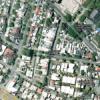Bent Street, Paddington, is one of the most curious streets in Sydney history. Although having only 32 houses in the street by 1920, this small street contained a cross section of Australian life during the time examined, from 1890 to 1920. The street contained shops, a coal depot, magistrates, landlords, labourers, miners, tenants, and all the other groups of people that inhabited the streets. In it also resided the first Australian Labor Party Prime Minister, John Christian Watson.
The street came into prominence when an article appeared in the Sydney Mail, 9 August 1916, p.12. It was inspired by the local ALP M.L.A., Mr. Osborne, who collected 29 portraits of soldiers from Bent and sent them Sydney Mail.
The album describes the named inhabitants of each house over the period from 1890 to 1920. In addition, the 29 pictures are named with a brief military biography attached to them. Where ever possible, they are located at the house in which the person lived.
The street numbering created a great deal of confusion amongst the information collectors. Where a dual number appears, this was the result of number confusion. For example, there never was No. 6 Bent Street but this did not prevent people from describing No. 8 as No. 6. In addition to that, in 1900, houses were built at numbers 23, 25, and 27. However No. 27 was further subdivided into three houses named "Osraston", "Matlock", and "Chellaston". This created its own confusion until the numbers were corrected in 1919. So the houses from 29 onwards have two numbers, the pre and post 1919 house number.
A full listing of the Bent Street Album may be found at:
Bent Street, Paddington Album Contents
BENT STREET, Paddington, recently became famous. The announcement that this little thoroughfare, comprising only 30 houses, had sent forth no fewer than 25 of its men to fight for their King and country created widespread interest, and the remark was commonly heard that Bent Street had set an admirable example, to the whole of the Commonwealth. Since that announcement the number of volunteers from the modest little street has been increased, and the "Mail" is now able (through the enthusiasm of Mr. Osborne, M.L.A., who collected the pictures) to publish portraits of 29 soldiers of the King who have gone to the front from their homes in Bent Street. Among them is Brigade-Major J. T. M'Coll, who is now stationed at Salonica as an officer in the Imperial Army. Previously, however, he had spent 12 strenuous months in France, and was in the thick of the fighting all the time. He, like most of the other volunteers, spent his boyhood in Paddington and learnt his first lessons at the local public school. He has three brothers at the war. Captain H. J. Connell was also educated in Paddington. His brother Charles was one of the first to enlist. He went to New Guinea with the first contingent, and is now in the firing lire "somewhere in France." Three of the lads have been promoted to sergeants' rank, and two others are corporals, while the rest are privates. Some of the heroes will never return. Corporal Jack J. Gough was killed in action on July 9, 1915, and sleeps on Gallipoli Peninsula, with comrades just as brave. Private Dan Wiles was stricken with meningitis while in Egypt, and he, too, lies buried on a faroff shore. Many others have been wounded, more or less seriously, and two - Privates E. C. Taylor and A. Artz - have returned to Australia, unfit for further service. Private H. E. Collins also came home, but has since gone back to the front.










